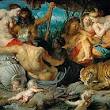In Search of the Perfect Piece of Art: Exploring Beauty and Creativity
The Beauty of a Masterpiece: Exploring the World of Art
Art has the incredible power to evoke emotions, spark creativity, and transcend boundaries. Every piece of art tells a story – whether through its vibrant colours, intricate details, or powerful symbolism. From classical paintings to contemporary sculptures, the world of art is a vast and diverse landscape waiting to be explored.
One of the most fascinating aspects of art is its ability to communicate across time and space. A piece created centuries ago can still resonate with viewers today, offering a glimpse into the thoughts and emotions of the artist. Whether it’s a Renaissance masterpiece or a modern installation, each work of art carries with it a unique narrative that invites interpretation and contemplation.
Art is not just about aesthetics; it is also a reflection of society, culture, and history. Through art, we can gain insights into different eras, traditions, and perspectives. A single painting can capture the essence of an entire epoch, while a sculpture can embody the spirit of a particular movement.
Visiting an art gallery or museum is like embarking on a journey through time and space. Each artwork offers a window into the artist’s mind – their inspirations, struggles, and triumphs. Whether you are drawn to classical portraits or abstract compositions, there is something for everyone in the world of art.
Art has the power to inspire us, challenge us, and provoke thought. It encourages us to see the world in new ways and explore our own creativity. So next time you encounter a piece of art – whether in a gallery or on the street – take a moment to pause, observe, and appreciate the beauty that surrounds you.
Let art be your guide as you navigate through life’s complexities and uncertainties. Allow yourself to be moved by its beauty and captivated by its mysteries. For in every stroke of paint and every chisel mark lies a story waiting to be discovered.
Exploring Art: Answers to 8 Common Questions
- What is art?
- What are the different types of art?
- How can I appreciate art?
- Who are some famous artists in history?
- What is the significance of art in society?
- How do artists express themselves through their work?
- What is the difference between modern and contemporary art?
- Where can I view famous pieces of art?
What is art?
The question “What is art?” has been a subject of debate and contemplation for centuries, with no definitive answer. Art can be seen as a form of expression, a reflection of society, an exploration of beauty, or a means of communication. It encompasses a wide range of creative endeavours, from painting and sculpture to music and dance. Ultimately, art is a deeply personal and subjective experience that evokes emotions, challenges perceptions, and invites interpretation. It is a powerful force that has the ability to inspire, provoke thought, and transcend boundaries.
What are the different types of art?
Art is a diverse and multifaceted realm that encompasses a wide range of styles, mediums, and techniques. Some of the different types of art include painting, sculpture, photography, drawing, printmaking, and mixed media. Each type of art offers unique opportunities for creative expression and exploration. Painting allows artists to convey emotions through colour and brushstrokes, while sculpture enables the creation of three-dimensional forms that interact with space. Photography captures fleeting moments in time, while drawing showcases the artist’s skill in line and composition. Printmaking involves intricate processes to produce multiple copies of an artwork, and mixed media combines various materials to create rich textures and layers. The variety of art forms ensures that there is something for every artistic inclination and preference.
How can I appreciate art?
To truly appreciate art, one must approach it with an open mind and a willingness to engage with the work on a deeper level. Start by taking the time to observe the piece carefully, noting its details, colours, and composition. Consider the artist’s intentions and the historical context in which the artwork was created. Allow yourself to connect emotionally with the piece and reflect on how it makes you feel. Don’t be afraid to ask questions or seek out additional information to gain a better understanding of the artwork. Remember that art is subjective, so trust your instincts and embrace your own unique interpretation of the piece. By immersing yourself in the world of art with curiosity and an open heart, you can truly appreciate its beauty and significance.
Who are some famous artists in history?
Throughout history, the world has been blessed with a multitude of talented artists whose works have left an indelible mark on the art world. Some of the most renowned figures include Leonardo da Vinci, known for his iconic painting “Mona Lisa” and “The Last Supper”; Vincent van Gogh, whose emotionally charged paintings like “Starry Night” continue to captivate audiences worldwide; Pablo Picasso, a pioneer of Cubism with masterpieces such as “Guernica” and “Les Demoiselles d’Avignon”; and Michelangelo, celebrated for his awe-inspiring sculptures like “David” and his work on the ceiling of the Sistine Chapel. These artists, among many others, have shaped the course of art history and continue to inspire generations with their creativity and vision.
What is the significance of art in society?
Art plays a vital role in shaping society by serving as a mirror that reflects our values, beliefs, and emotions. It has the power to provoke thought, inspire change, and foster cultural understanding. Through art, we can express complex ideas, challenge norms, and celebrate diversity. Art enriches our lives by offering new perspectives, stimulating creativity, and providing a platform for dialogue. It helps us connect with our past, make sense of the present, and envision a better future. In essence, the significance of art in society lies in its ability to unite us, inspire us, and remind us of our shared humanity.
How do artists express themselves through their work?
Artists express themselves through their work by using a unique blend of creativity, skill, and personal vision. Each brushstroke, sculpted form, or captured image is a reflection of the artist’s inner thoughts, emotions, and experiences. Through their chosen medium, artists convey their perspectives on the world around them, addressing themes such as identity, culture, politics, and nature. Whether through bold colours, intricate details, or abstract forms, artists infuse their creations with a part of themselves, inviting viewers to engage with their art on a deeper level and explore the complexities of human expression.
What is the difference between modern and contemporary art?
The distinction between modern and contemporary art lies in their respective time periods and artistic movements. Modern art typically refers to the art produced between the late 19th century and the 1960s, encompassing movements such as Impressionism, Cubism, and Surrealism. On the other hand, contemporary art refers to art created from the 1960s onwards to the present day, reflecting the diverse and evolving artistic practices of today. While modern art is associated with groundbreaking innovations and avant-garde experimentation, contemporary art embraces a wide range of styles, mediums, and concepts that reflect the complexities of our modern world. Ultimately, both modern and contemporary art offer unique insights into the ever-changing landscape of artistic expression.
Where can I view famous pieces of art?
If you are eager to view famous pieces of art, there are numerous renowned art galleries and museums around the world where you can immerse yourself in the beauty and history of iconic artworks. From the Louvre in Paris, home to the enigmatic Mona Lisa, to the Metropolitan Museum of Art in New York City, showcasing a vast collection of masterpieces, there is no shortage of cultural institutions that house some of the most celebrated pieces of art. Additionally, cities like Florence, London, and Madrid boast world-class galleries that offer a glimpse into the artistic legacies of great masters such as Michelangelo, Rembrandt, and Picasso. Whether you prefer classical paintings or contemporary sculptures, these cultural hubs provide an enriching experience for art enthusiasts seeking to witness renowned works up close.


